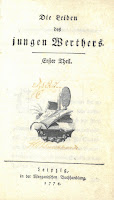 This year marks the 200th anniversary of the first printing of Mary Wollstonecraft Shelley's novel Frankenstein; or, the Modern Prometheus. We've blogged previously about our first illustrated edition of the novel, which is always available for perusal here in Special Collections. To celebrate the publication of this ground-breaking work, we soon will install an exhibit about Shelley's most famous title in the Class of 1965 Galleries. To whet your appetites, this post will focus on one of the works of literature that Frankenstein's monster found in the pockets of his creator's abandoned coat.
This year marks the 200th anniversary of the first printing of Mary Wollstonecraft Shelley's novel Frankenstein; or, the Modern Prometheus. We've blogged previously about our first illustrated edition of the novel, which is always available for perusal here in Special Collections. To celebrate the publication of this ground-breaking work, we soon will install an exhibit about Shelley's most famous title in the Class of 1965 Galleries. To whet your appetites, this post will focus on one of the works of literature that Frankenstein's monster found in the pockets of his creator's abandoned coat.Along with Milton's Paradise Lost and Plutarch's Lives of Illustrious Greeks and Romans, the monster also finds a small epistolary novel titled The Sorrows of Young Werther. This semi-autobiographical novel was written in 1774 by a young man named Johann Wolfgang von Goethe, who would later go on to write Faust. The narrative follows the trials and tribulations of an emotional artist, Werther, who becomes trapped in a love triangle and eventually commits suicide to allow his love interest and her husband to live in peace. The novel elevated Goethe from obscurity to stardom overnight and was central to the Sturm und Drang literary movement in Germany that espoused a sort of proto-Romanticism.
The influence of Goethe and the Sturm und Drang movement clearly had an influence on the
Romanticists of the early 19th century. Shelley's inclusion of the text as a seminal influence on the education of her fictional monster draws a direct connection between the two groups of writers. Frankenstein's monster finds a kinship with the titular character of Goethe's protagonist; he is similarly rejected by the ones that he loves and is left alone to suffer. However, the monster pursues a different recourse than Werther, choosing to seek revenge for his rejection instead of self-destruction. Admittedly, the monster does end his own life amongst the frozen ice floes of the Arctic, but only after murdering all of the people that were loved by his creator.
We have a first edition in the original German of this lovely little book. To take a look, come into Rauner and ask to see Rare PT1973 .A2 1774.

No comments :
Post a Comment